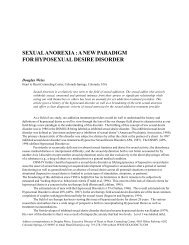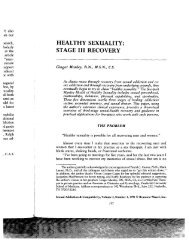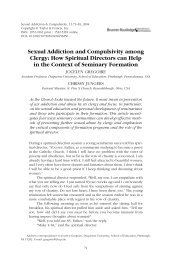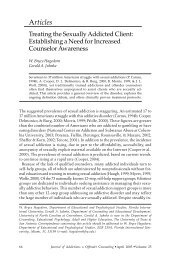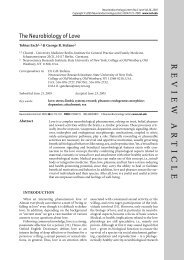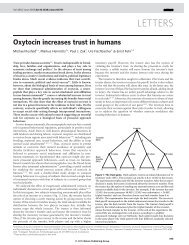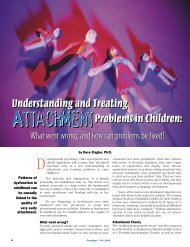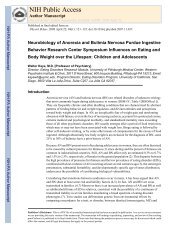recognizing and managing erotic and eroticized transferences
recognizing and managing erotic and eroticized transferences
recognizing and managing erotic and eroticized transferences
You also want an ePaper? Increase the reach of your titles
YUMPU automatically turns print PDFs into web optimized ePapers that Google loves.
childhood experiences. Later he<br />
observed that feelings of love not<br />
only occurred in the past outside<br />
the therapy session, but also during<br />
the analysis itself toward the<br />
analyst. 3<br />
Sexualized transference is any<br />
transference in which the patient’s<br />
fantasies about the analyst contain<br />
elements that are primarily<br />
reverential, romantic, intimate,<br />
sensual, or sexual. 4 As early as<br />
1915, Freud addressed this<br />
phenomenon in his paper,<br />
“Observation on Transference<br />
Love.” 3 He described transference<br />
love as occurring when the patient<br />
openly announces love for the<br />
therapist.<br />
At the time Freud wrote about<br />
“transference love,” the field of<br />
psychoanalysis was under attack by<br />
the public. Some of these attacks<br />
centered on reports of sexual<br />
experiences between analysts <strong>and</strong><br />
their patients. Freud struggled with<br />
whether transference came from<br />
the real relationship between the<br />
patient <strong>and</strong> therapist or if it was<br />
entirely unreal (i.e., displaced<br />
feelings from other relationships).<br />
Today there are ongoing<br />
discussions in the literature about<br />
the nature <strong>and</strong> role of transference.<br />
The transference relationship is<br />
complex <strong>and</strong> multilayered while<br />
being significantly impacted by<br />
countertransferential reactions.<br />
The therapist has become less of a<br />
“blank screen” <strong>and</strong> more<br />
interactive with the patient <strong>and</strong>,<br />
therefore, a part of the developing<br />
transference. Transference may be<br />
utilized to gather psychological<br />
material <strong>and</strong> gain a deeper<br />
underst<strong>and</strong>ing of the patient’s<br />
motivations. 5 Contemporary<br />
analysts contend, as their<br />
predecessors once did, that <strong>erotic</strong><br />
transference reflects a patient’s<br />
early life impulses <strong>and</strong> fantasies<br />
that emerge during the process of<br />
analysis.<br />
TYPES OF TRANSFERENCE<br />
In general, transference may<br />
manifest itself as positive, negative,<br />
or sexualized. In positive<br />
transference, the patient<br />
experiences enjoyable aspects of<br />
past relationships. Positive<br />
<strong>transferences</strong> are often helpful in<br />
therapy if the patient sees the<br />
therapist as wise, caring, <strong>and</strong><br />
concerned.<br />
Negative transference<br />
unleashes emotions that are painful<br />
or less desired. By discussing these<br />
negative emotions with the patient,<br />
the therapist hopes to help the<br />
patient achieve insight <strong>and</strong> to find<br />
ways to manage these feelings.<br />
Positive <strong>and</strong> negative<br />
transference can become topics for<br />
discussion in therapy. The patient<br />
is encouraged to acknowledge <strong>and</strong><br />
discuss emotional responses to the<br />
therapist, especially if they seem<br />
out of proportion to what has<br />
actually transpired in the session<br />
Positive <strong>and</strong> negative transference can become<br />
topics for discussion in therapy. The patient is<br />
encouraged to acknowledge <strong>and</strong> discuss<br />
emotional responses to the therapist, especially<br />
if they seem out of proportion to what has<br />
actually transpired in the session itself.<br />
itself. This allows patients to make<br />
connections between what they are<br />
feeling in the room with their<br />
therapist <strong>and</strong> their early life<br />
experiences, <strong>and</strong> this enables<br />
development <strong>and</strong> growth.<br />
Transference situations that are<br />
not interfering with the therapeutic<br />
process are often left<br />
uninterpreted. It can be a technical<br />
challenge to address transference<br />
in therapy, because raising<br />
awareness to the transference can<br />
stress the patient, leading to<br />
regression or awkward <strong>and</strong><br />
embarrassing moments in therapy.<br />
The acknowledgment of<br />
transference feelings, if sexual, may<br />
be mistaken as an invitation for<br />
further flirtation or a sexual<br />
relationship. This could lead to the<br />
collapse of the safe environment the<br />
therapist has struggled to create. 6 It<br />
is of course unethical to use the<br />
discussion of the intense feelings<br />
involved in the transference for a<br />
therapist’s own self-gratification,<br />
<strong>and</strong> this is to be avoided.<br />
COUNTERTRANSFERENCE:<br />
BOUNDARY ISSUES FOR<br />
PSYCHOTHERAPISTS<br />
The intense emotional<br />
experience of countertransference<br />
in psychotherapy also is not rare.<br />
Some studies have reported that 95<br />
percent of male therapists <strong>and</strong> 76<br />
percent of female therapists admit<br />
that they felt sexual feelings toward<br />
their patients. 6 Identifying <strong>and</strong><br />
therapeutically <strong>managing</strong> one’s own<br />
intense feelings is one of the ongoing<br />
challenges of<br />
psychodynamically based<br />
psychotherapy. These challenges<br />
are enhanced in the novice<br />
therapist who may have little<br />
training in these issues <strong>and</strong> virtually<br />
no experience with them.<br />
PRACTICE POINT: Family of<br />
Origin Issues <strong>and</strong> Potential for<br />
Transference in the Therapeutic<br />
Relationship<br />
Case example. A middle-aged<br />
woman describes her childhood<br />
as being filled with rage. She<br />
attributes this to her emotionally<br />
abusive father <strong>and</strong> sexually<br />
abusive brother. She states that in<br />
order to enhance her sense of<br />
safety, she developed techniques<br />
to control <strong>and</strong> manipulate her<br />
father.<br />
In psychotherapy with a male<br />
therapist, a patient might display<br />
48<br />
Psychiatry 2007 [APRIL]



